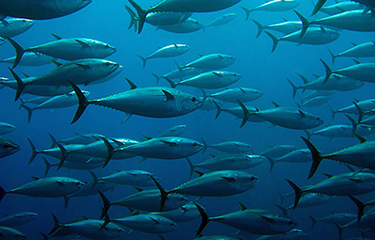New research showed that there is evidence of tuna spawning inside the large marine protected area of the Phoenix Islands in the Pacific nation of Kiribati.
The research conducted by MIT and the Woods Hole Oceanographic Institution points to evidence that marine protected areas (MPAs) can play a critical role in protecting adult fish, including highly migratory species such as tuna, during spawning.
MPAs mandate that no extraction or fishing of any kind can be conducted within designated area borders.
The research was supported by the PIPA Trust, the Sea Education Association, the Prince Albert of Monaco Foundation II, the New England Aquarium, and Boston University.
The Phoenix Islands Protected Area (PIPA) covers 410,500 square kilometers (158,500 square miles) of Kiribati’s exclusive economic zone and is known as the world's largest marine protected area.
The research, published in Scientific Reports in late July 2019, determined that PIPA is a spawning area for skipjack, bigeye, and yellowfin tuna.
“By combining three years of empirical data on larval tuna in PIPA with a biophysical modeling approach to backtrack larvae to infer spawning locations, we have conclusively demonstrated that spawning occurs inside PIPA for skipjack, bigeye, and yellowfin tunas,” the research stated.
The researchers analyzed the larvae and monitored PIPA from 2015 to 2017. The paper said that even during the El Niño phenomenon in 2015, the abundance of tuna larvae did not change.
“We have proven that tuna are spawning in this protected area and that it’s worth protecting,” Christina Hernández, a graduate student in MIT’s Department of Earth, Atmospheric, and Planetary Sciences told MIT News. “There are various types of protection for marine areas around the world, and all those measures allow us to preserve populations better, and in some cases protect highly migratory species."
Despite being highly migratory, tuna populations can become well-stocked thanks to MPAs, which create “potential for regional economic gain via spillover effects that may materialize once the closure has been in place long enough,” the paper stated.
There is a lot of controversy over whether marine protected areas are useful for large and highly migratory animals like tunas because they move in and out of protected areas.
However, protection of adult tunas while spawning can have positive benefits for the population, even if the adults are later caught by fishing gear outside the protected area, Dr. Randi Rotjan of Boston University, a co-author and close collaborator with the government of Kiribati, said in a press release.
The work put into PIPA also goes to show that large MPAs “are large-scale living laboratories that can help scientists better understand ocean ecosystems,” according to the paper.
The paper also added that PIPA may be critical for the conservation of tuna populations affected by climate change.
Several papers have predicted that climate change will change tuna habitats in the Pacific, but the PIPA monitoring appears to show that that MPAs could allow fish to thrive across environmental conditions, even during strong El Niño season.







